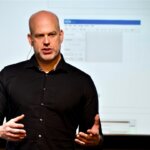The benefits of a modern research project platform

If you need a modern research project platform to co-ordinate and streamline your multi-strand research projects, there are a handful of things you’ll need to consider – not least a healthily detailed specification of what your company’s needs really are, so that you can provide your platform builder with all the data they need.
In Part 1 of this article, we sat down with Joanna Dumont, VP of Strategy & Insights at Danone, the worldwide brand-parent, because the company has a heavy research need, and it recently implemented a modern research project platform with Stravito – a specialist company in the field.
We also spoke to Thor Philogéne, Stravito’s CEO, to understand the process of building a modern research project platform that can make running research projects around the globe easier for everyone involved.
We asked Joanna exactly how Danone came up with its build requirements for this 21st century research platform.
Joanna and the giant To-Do list.
JD:
We’ve been working together very closely for the last few years and building a platform for Danone that works within our company’s lines. So we worked together to define what the functionalities were that we would like, and I literally gave Stravito a wish list. I said “These are all the things that I would love for this platform to be able to do. I want it to connect to this and I want it to be able to leverage our best practices and be in the platform. And it needs to make our research process easier.”
And because I know how we do things, and talking to my teams, we understood what we do, the trick was transferring that and making that digital, with this overarching brief of saying “We want this to be an assist to you, we want this to make your life easier.”
And I knew when I gave the brief to Stravito that this was not an easy problem to solve. But so far the feedback has been incredible, and people who are working with the platform are very excited about the possibilities and how it delivers on those critical challenges that I gave to Stravito.
THQ:
Since you began working on this modern research project platform, have there been any big, surprising moments?
JD:
The point of this development wasn’t so much to go “Oh, this is new stuff.” Nobody knows everything, of course, but I’d have almost been surprised if it had uncovered anything that we didn’t know, or that surprised us.
But hopefully, what it helps us do is allow somebody in another country to go into the platform, and find another project that was done that was very similar to their own, and let them easily extract that, so there’s minimal duplication of research effort.
And in an organization that’s as big as this, with upwards of 20,000 projects on the system and access to tons of data, you can imagine, there’s no way that you as a human being can possibly know where to go and find that information. So for us, the big reveal is more that people now have the capability of accessing information that they didn’t have at their fingertips before.
So the surprises aren’t on our end as the architects of the system, but hopefully the platform will enable surprises for researchers when they discover all the relevant data it contains for them.
The advantage of modernity.
THQ:
They don’t make ’em like they used to, do they?
JD:
Hey, I’ve been doing this for a long time, since before these kinds of platforms existed. I’d have to go back and remember “There was that person in this country, and I think they worked on this, I’m gonna send them an email or call them on the phone, and I’ll see if they’ve got that piece of research, and they can send it to me.”
THQ:
Ah, the techno-stone age. We remember it well. Not fondly, but well.
JD:
Exactly. And that was in a global organization, that was how it worked. There were folders with papers, it was a library, literally a library that we used to hold all that. So the big reveal of this development is more that it helps us to see what we know already very quickly and easily, and then be able to act on that as quickly as we can.
Delivering enterprise insights.
THQ:
Thor – Stravito built Danone’s modern research project platform. How does it work?
TP:
That’s a broad question.
THQ:
Evil, isn’t it? “Tell us everything you know about everything in a handful of sentences.”
Let’s break it down. Tell us how the enterprise insights platform that’s Stravito’s more usual meat and drink works first, then we can drill down into the Danone build.
TP:
Sure. Our enterprise insights platform allows very large companies like Danone to create one central hub for all their first, second and third party research, their insights, and tie them in to external analytics data, and then to make all of that information available to all employees.
Now, what we are doing on the back end is combining our AI with a user-friendly experience, and we do that so we can bring insights to the fingertips of the teams around the world. So we figure out how we can do that in a way that feels very much like a consumer product. How can we do it in a way that does not involve any manuals, or any training?
THQ:
The instant adoption Joanna mentioned in Part 1?
TP:
Yes, because we want it to be immediately useable – and useful – to people, rather than it being a chore to learn. Core corporate software should be as easy, as personalized, and as fun to use as consumer applications like Netflix and Spotify, things people use every day, but also want to continue using.
That’s kind of been our mindset from day one. Simplify knowledge discovery, centralize access to insights, deliver an intuitive and friendly interface.
A new level of research management.
But of course, there’s much more we can do to help companies these days. We’re thinking about how we can take our core principles to the next level, and launching our new research management offering. In very simple terms, that simplifies research project management, and allows teams within these large global organizations a very comprehensive way to manage their research projects from one place.
THQ:
So you’re combining vast amounts of complex data in diverse locations, and putting it at the beck and call of any researcher in the company’s ecosystem, via a consumer-simple, friendly interface?
TP:
Right.
THQ:
When you get that To-Do list, as Joanna mentioned, the list of must-haves in the platform, what’s the process of taking your usual offering and tailoring it to the client’s needs?
TP:
What the client is looking for is a solution to their particular problems or challenges, or something that unlocks new potential for them. Whether we deliver that with software or magic, it doesn’t really matter.
THQ:
We’re going to guess you deliver with software, though… Right?
TP:
Right.
In the case of Danone, we’ve worked with the company since 2018, helping them centralize their insights so that they can integrate the knowledge that’s being accessed and share insights from one space to make more informed decisions.
The best collaboration.
Now they were looking for a tool to help them manage the actual research project process with ease. So we worked collaboratively, listened to their requirements, and built the product that we believe solves the problems that they had.
The best collaboration is where two sets of expertise come together, and that’s really the process behind this development. Danone were the experts in the problems any solution had to solve and the functionality it had to deliver. We were the experts on product development and user experience.
Good collaboration depends on mutual understanding and occasional education – they educated us on why things needed to solve problems in particular ways, we educated them sometimes on the way we thought we could best solve those problems.
That was one of the main things – there’s all this complicated stuff going on behind the scenes, but solving the issue of delivering all that functionality with a simple, friendly user experience was challenging, because making something complicated look easy is always hard.
But being aware of where of all the complexities are on the user end is what allows us to really hone in on solving that. That’s why we’ve done things like having everything in one place, and building the chat functionality – that was an example of something that was not on our initial radar at all, removing the need to send time-consuming emails. That’s a very concrete example of how things materialized in the build.
What’s next?
THQ:
A final question, Joanna. What’s next?
JD:
Oh, we will continue to go further. Our goal is to make this a one-stop shop for everything to do with insights, but we can see this going much deeper in the organization. Knowledge management is not just a problem that starts and ends with the research component of the business; it has potential to do so much more. And the efficiencies that a big organization can gain by having much more transparency and access to knowledge are never-ending.
So we’ll do research management, we’ll do something around budgets, probably, but beyond that, I can see this having so much more utility within the organization. And because of the success so far of what we’ve done over the last few years, we’re getting more and more people across the organization asking for more from this.
I personally think it’s got more potential in the business overall.










